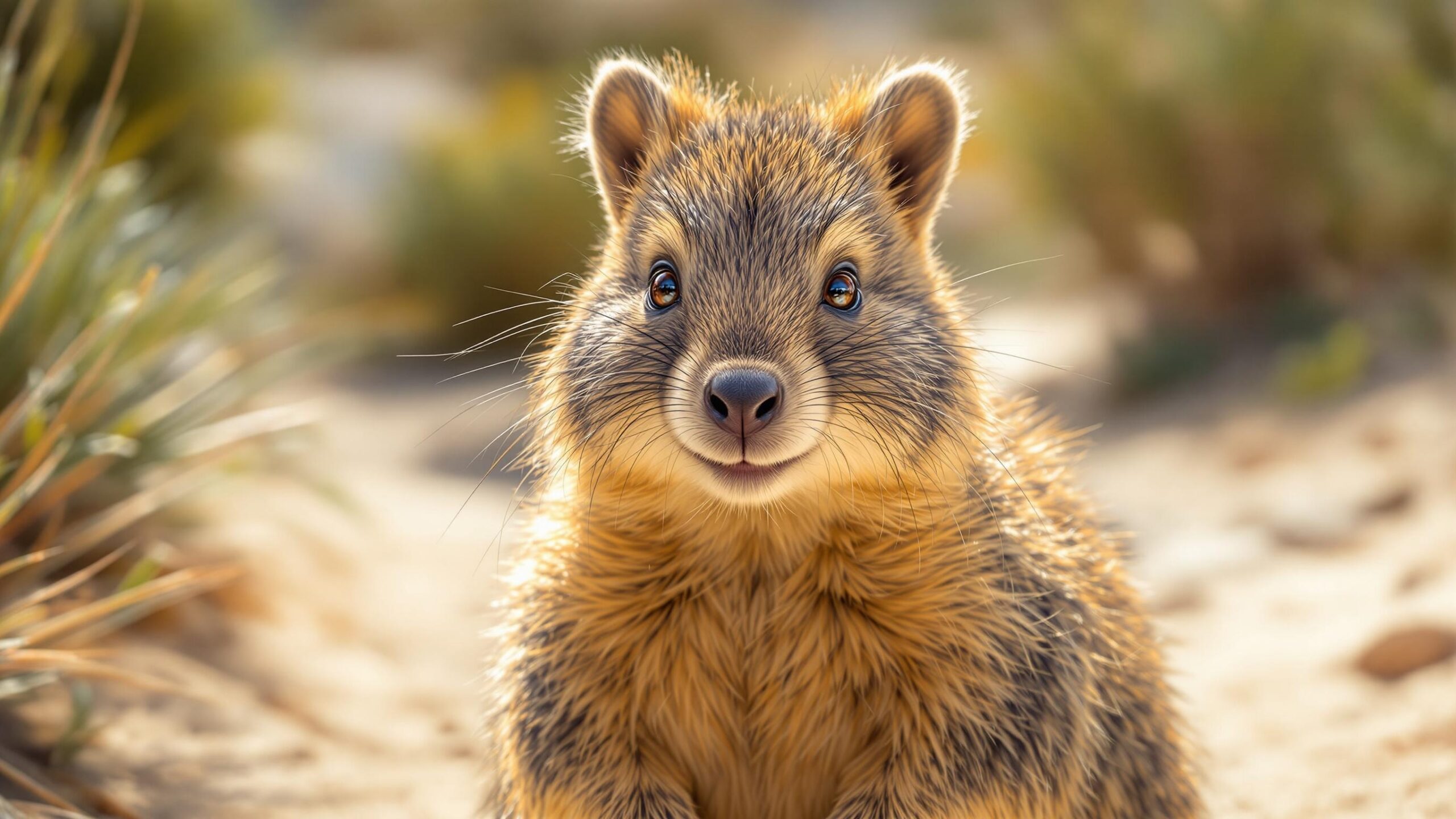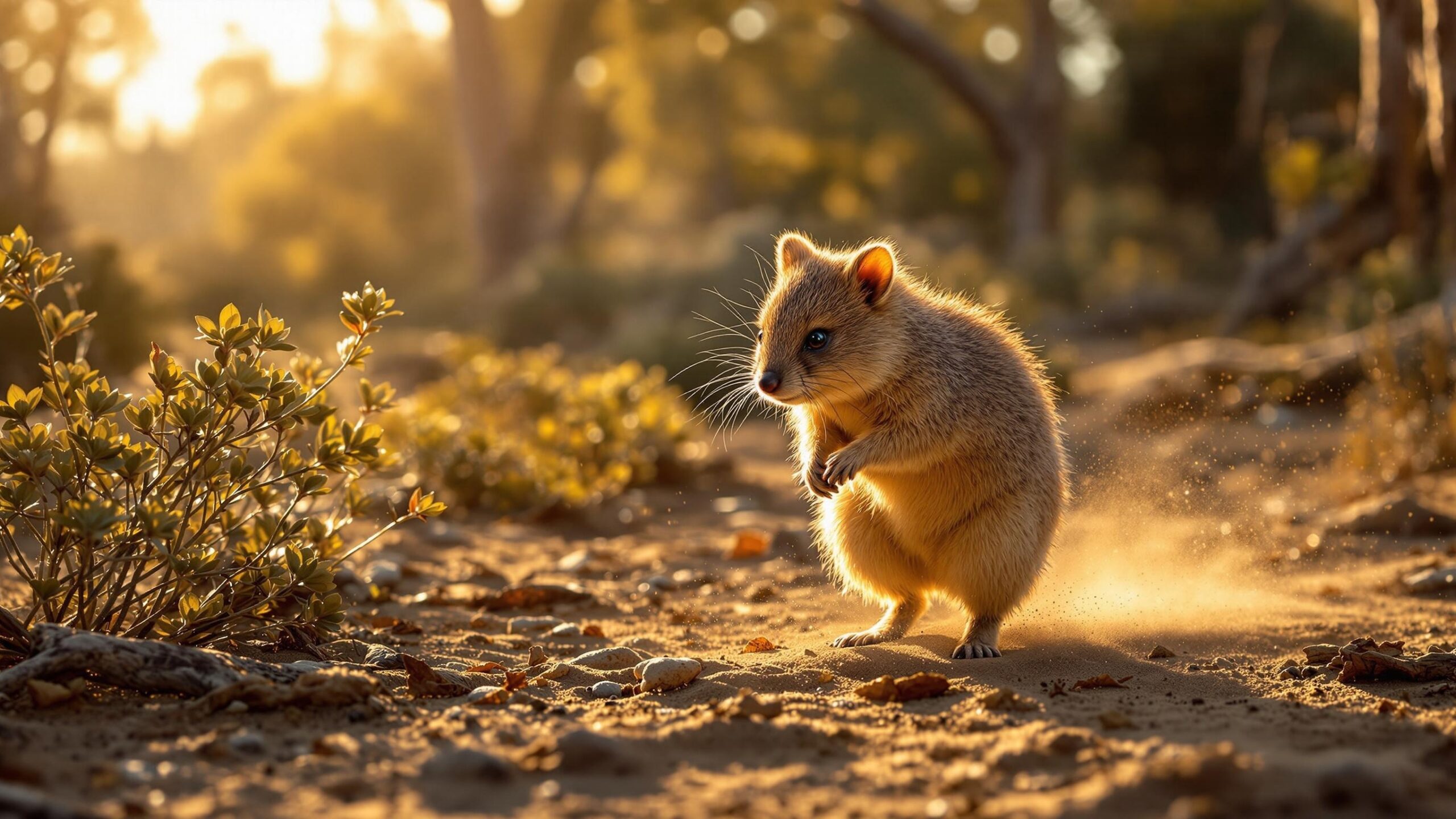The World’s Happiest Marsupial
With a perpetual grin on its face and a laid-back attitude that seems to say “no worries,” the quokka (Setonix brachyurus) has charmed the internet and captivated wildlife lovers across the globe. Often dubbed the “world’s happiest animal,” this small marsupial has become an unlikely global celebrity. But behind that famously cheerful smile is a fascinating species with a unique place in Australia’s rich ecological tapestry. Native to a few small areas in Western Australia, the quokka is not just photogenic—it’s a resilient survivor, a crucial ecosystem participant, and a symbol of conservation success and caution.
A Unique Marsupial
The quokka is a member of the macropod family, which also includes kangaroos and wallabies. Like its larger cousins, the quokka is a herbivorous marsupial equipped with powerful hind legs, a sturdy tail, and a pouch in which females carry their young. It is the only living member of its genus, Setonix, making it a monotypic species of particular scientific interest. First documented by European explorers in the 17th century, the quokka was mistaken by Dutch navigator Willem de Vlamingh as a giant rat. In fact, he thought Rottnest Island—where many quokkas live—was crawling with rats and named it accordingly. “Rottnest” literally means “rat’s nest” in Dutch.
Although often called the happiest animal on Earth, that impression comes from its facial anatomy—its upturned mouth, round cheeks, and large, dark eyes give it an expression that humans interpret as a constant smile. While the quokka may not actually be grinning for the camera, there is no denying that its seemingly joyful demeanor has helped draw global attention to this lesser-known marsupial.
Where Quokkas Call Home
Quokkas are found almost exclusively in the southwestern corner of Western Australia. While small mainland populations still exist in protected areas, the largest and most stable population resides on Rottnest Island, a car-free, predator-free paradise located about 11 miles off the coast of Perth. A smaller population also thrives on Bald Island, off the southern coast, where conservation efforts have successfully protected them from predators.
On the mainland, quokkas inhabit dense vegetation near swamps, forests, or scrubby thickets. They prefer areas with access to water and a cover of native shrubs and grasses, which offer both food and protection. However, habitat loss, urban development, and the introduction of invasive species such as foxes and feral cats have drastically reduced their numbers across their historical range.
Rottnest and Bald Islands serve as vital sanctuaries. With no natural predators and limited human intrusion (especially on Bald Island), these habitats allow quokkas to live largely undisturbed, helping maintain stable populations and offering opportunities for research and ecotourism.
What Does a Quokka Look Like?
A quokka is roughly the size of a domestic cat. Adults typically weigh between 5.5 and 11 pounds (2.5 to 5 kilograms) and measure around 16 to 21 inches (40 to 54 centimeters) in body length, with a tail that adds another 10 to 12 inches (25 to 30 centimeters). Covered in short, coarse brown fur with lighter underparts, quokkas have rounded ears, a stout body, and a long, hairless tail used mainly for balance rather than locomotion.
Their hind legs are strong and adapted for hopping, though not with the power or speed of a kangaroo. Quokkas are relatively slow movers, which makes them vulnerable on the mainland but also contributes to their relaxed demeanor in protected areas. Their faces are what steal the show—rounded with prominent whiskers, dark button eyes, and that signature smile.
Quokka Behavior: Curious, Confident, and Social
Quokkas are mostly nocturnal, meaning they are most active during the night and early morning hours. During the day, especially in the heat, they rest in cool, shaded spots among the vegetation. Unlike many other small mammals, quokkas display an unusual boldness around humans, particularly on Rottnest Island where they are protected and accustomed to tourists.
They are generally solitary or live in loose communities with overlapping territories. Although not aggressively territorial, they do maintain home ranges and can be seen sharing food sources or shelter areas. They communicate using a range of vocalizations and body language, including low growls, soft grunts, and a distinctive alarm call that warns of nearby threats.
Quokkas are curious by nature. On Rottnest, it’s not uncommon for one to hop up to a cyclist, tourist, or parked backpack to investigate. While this behavior has earned them a reputation for being friendly or tame, it’s important to remember that these are wild animals and should never be handled, fed, or disturbed—both for their safety and the integrity of the ecosystem.
Diet and Foraging Habits
Quokkas are herbivores, feeding primarily on native grasses, leaves, stems, and bark. On Rottnest Island, they’ve adapted to a somewhat limited menu but manage well by selecting drought-resistant vegetation and even re-ingesting partially digested food (similar to cud-chewing in cows) to maximize nutrient absorption.
Their diet varies with season and availability. In wetter months, they enjoy green shoots and soft foliage, while in drier conditions, they turn to tougher shrubs, bark, and moisture-storing plants. Quokkas have a unique ability to survive for long periods without free-standing water, deriving most of their moisture from the plants they eat. This remarkable adaptation is key to surviving in Australia’s often harsh and arid environments.
However, human interaction has disrupted these natural foraging behaviors, especially on Rottnest. Tourists sometimes feed quokkas inappropriate foods like bread or fruit, which can cause digestive issues, malnutrition, and even death. Education campaigns and strict regulations are in place to prevent this, but enforcement remains an ongoing challenge.
Quokka Reproduction and Life Cycle
Like other marsupials, quokkas give birth to very underdeveloped young, known as joeys, which complete their development in the mother’s pouch. Breeding usually occurs once a year, with most births happening between January and March, depending on environmental conditions.
After a gestation period of just 27 days, the tiny, jellybean-sized joey crawls into its mother’s pouch, where it remains for about six months. After emerging, the joey stays close to its mother, continuing to nurse and learn survival skills until it becomes more independent. Quokka mothers can reproduce again while still nursing a joey, thanks to a process known as embryonic diapause, where a fertilized embryo remains dormant until the pouch is vacated.
This reproductive strategy allows for rapid population recovery in favorable conditions. In the wild, quokkas typically live around 5 to 10 years, with many not surviving to adulthood due to predation or environmental pressures. On predator-free islands, they can live longer, especially under conservation care.

Natural Predators and Threats
In their mainland habitats, quokkas face a number of natural and introduced predators. Dingoes, snakes, and birds of prey historically kept populations in check. However, the introduction of foxes and feral cats has had a devastating effect on quokkas and many other small to mid-sized Australian mammals. These predators hunt primarily at night and have contributed to significant population declines.
In addition to predation, habitat loss due to land clearing, agriculture, and development has reduced the availability of suitable shelter and food. On Rottnest Island, the lack of predators is a double-edged sword. While it offers safety, the high population density in some areas has led to disease outbreaks and competition for resources.
Bushfires also pose a serious threat. As climate change leads to more frequent and intense fires in Australia, small, isolated populations like those of the quokka are especially vulnerable. Recovery from such events is difficult without sustained conservation efforts and habitat restoration.
Conservation Efforts: A Cautious Success Story
The International Union for Conservation of Nature (IUCN) currently lists the quokka as “Vulnerable,” meaning it faces a high risk of extinction in the wild over the medium term. That status may come as a surprise to casual admirers, given the animal’s apparent abundance on Rottnest Island. But the broader picture is more complicated.
The Rottnest population represents a conservation success—a thriving, visible group protected from the mainland’s dangers. However, the species’ overall distribution is limited and fragmented. Mainland populations are small and declining, and without sustained habitat protection and predator control, they remain at risk.
Conservation strategies focus on habitat preservation, predator management, fire control, and public education. Programs also include genetic studies to ensure the long-term viability of isolated populations, and in some cases, captive breeding and reintroduction efforts. Bald Island, for example, serves as an important “insurance population,” protected by its remoteness and careful monitoring.
The key to quokka conservation lies not only in protecting charismatic island populations but also in restoring balance and biodiversity on the mainland. Community involvement, government support, and scientific research all play essential roles in that effort.
The Quokka Selfie Phenomenon
It would be impossible to discuss the quokka without mentioning the cultural phenomenon that catapulted this marsupial to global fame: the quokka selfie. Over the past decade, tourists visiting Rottnest Island have snapped thousands of photos posing beside smiling quokkas, often sharing them across social media platforms. Celebrities, influencers, and travel bloggers have all contributed to the trend, cementing the quokka’s place as an internet darling.
While this attention has raised awareness and boosted tourism, it has also sparked controversy. Some conservationists worry that the selfie craze may harm the quokkas, encouraging close human interaction, stress, and inappropriate feeding. In response, local authorities have launched “Look, Don’t Touch” campaigns, encouraging responsible tourism that prioritizes the animal’s welfare.
Efforts include signage, fines for feeding or touching wildlife, and education through visitor centers. Responsible tourism has the power to be a force for good—raising funds, supporting conservation, and inspiring care for nature—but it must be handled with care.
A Symbol of Australia’s Unique Biodiversity
The quokka is more than just a cute face—it’s a symbol of Australia’s extraordinary biodiversity and the delicate balance that sustains it. As a species found nowhere else on Earth, the quokka represents a lineage that evolved in isolation, adapting to a harsh landscape through resilience and evolutionary ingenuity.
Its story highlights both the triumphs and challenges of modern conservation. Where humans have acted to protect and restore natural systems, the quokka has flourished. Where we’ve introduced threats and neglected habitats, populations have declined. This duality makes the quokka a living reminder that coexistence is possible, but never automatic.
In many ways, the quokka embodies the potential of conservation done right. It has bounced back in places where protective measures were enforced and now serves as a flagship species for Western Australia’s unique ecosystems. When people rally around a cause—even if that cause wears a fuzzy smile—the results can be transformative.
More Than a Smile
The quokka’s story is one of charm, survival, and ecological importance. Beneath its endearing expression lies a tale of adaptation, perseverance, and interconnection with the Australian landscape. It’s easy to be enchanted by its appearance, but it’s even more meaningful to understand and appreciate the creature behind the smile.
As one of Australia’s most beloved marsupials, the quokka invites us to care—not just about the animals we can photograph, but about the ecosystems that support them, the threats they face, and the actions we can take to ensure their future. From the bushy thickets of the mainland to the sandy trails of Rottnest, the quokka continues to hop through life with resilience, reminding us all that joy and hope are powerful allies in the world of wildlife conservation.

